
How do you know when it’s safe to return to climbing? When can you expect to send again?
The post What’s the Post-Baby Beta? How to Return to Climbing After Pregnancy appeared first on Climbing.
]]>
A new mother’s return to exercise can be daunting. You’ve gone through a nine-month marathon of pregnancy and, while there were many resources during your pre-natal journey, the resources may seem to run dry after the baby arrives. Most women in the U.S. get a single six-week postpartum checkup, after which they are cleared for exercise with little advice or resources on how to safely return to high-intensity activities.
Rock climbing is an especially complicated sport to return to, as it requires core strength—including the pelvic floor, an area that has undergone massive changes. So, what’s the beta? How do you know when it’s safe to return to climbing? When can you expect to send again?
What’s the deal with the core and pelvic floor?
Think of your abdomen like a canister. It’s surrounded by your spine and back muscles in the rear, the abdominals in front, the diaphragm above, and the pelvic floor below. These structures work together to manage pressure when you perform any activity—from easy breathing to a tension-y overhung climb.
During pregnancy and postpartum, these structures undergo massive changes. The connective tissue in between the “six pack” abdominal muscles, called the linea alba, thins and widens to allow room for the belly to expand. This is known as diastasis recti. It is a normal and necessary part of pregnancy.

After birth, the linea alba narrows and the abdominal muscles rejoin. But for some people, this gap remains and is known as diastasis recti. It is typically measured by finger widths, and two or more finger widths is considered abnormal. Research shows that increased diastasis recti is associated with worse abdominal function.(1) More importantly, research shows that regardless of the presence of diastasis recti, postpartum women have decreased abdominal strength and endurance.(1) Bottom line: abdominal strengthening should be a goal for all women postpartum.
Research shows that the pelvic floor is affected during pregnancy and postpartum as well. The pelvic floor lengthens during pregnancy. Typically, the core and pelvic floor naturally co-contract, helping to effectively manage intra-abdominal pressure. For both vaginal and C-section delivery, these two structures don’t always co-contract postpartum, leading to poor pressure management.(2) For example, if you experience leaking of urine during exercise or coughing, your pelvic floor might not be adequately functioning to manage pressure. While this is a common experience for women postpartum, it is not normal and can be addressed!
So we know pregnancy and childbirth adversely affects the abdomen and pelvic floor. What can we do about it?
Off the wall: weeks 1-6 postpartum
During early postpartum, the primary goal is to reconnect to your core and pelvic floor and prioritize gentle muscle contractions. This is typically done first through breath work. Early on, while you are enjoying all the baby snuggles—and desperately sneaking in naps—get started with these simple exercises. They can be done every day as long as no pain is experienced.
Diaphragmatic breathing + abdominal contraction
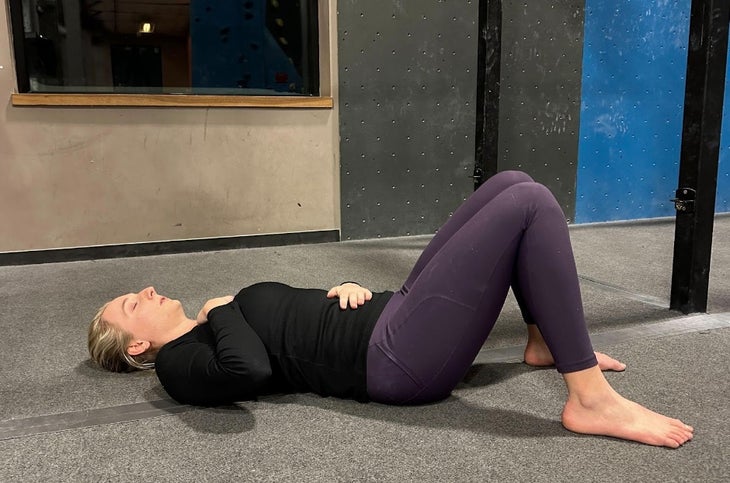
- Start in a comfortable position lying on your back with your feet on the ground
- Place one hand on your belly and one hand on your chest
- Slowly inhale through your nose
- Focus on breathing into your belly and expanding your rib cage out and up
- As you slowly exhale through your mouth, gently draw your belly in and towards your spine, activating and contracting your core muscles
- These breaths should be slow and controlled, focusing on connecting with your abdominal muscles
- Repeat 10 times
Diaphragmatic exhale with balloon
The diaphragmatic breathing above can also be combined with exhaling into a balloon to provide light resistance to the abdominal muscles and cue their contraction further. Here’s how:
- Start in a comfortable position lying on your back with your feet on the ground
- Place a balloon in your mouth
- Inhale through your nose, focus on breathing into your belly and expanding your rib cage out and up.
- With the exhale, inflate the balloon. Focus on gently drawing your belly in and towards your spine, activating and contracting your core muscles.
- Continue to fill the balloon more and more with each exhale
- Repeat 10 times
Pelvic floor contractions and relaxations
While laying on your back, you can begin gently contracting and relaxing the pelvic floor, an exercise called a kegel. Here’s how:
- Start in a comfortable position lying on your back with your feet on the ground
- Gently contract your pelvic floor, imagine drawing it up and in as if to stop the flow of urine
- Hold for 3 seconds
- Release and fully relax your pelvic floor for 3 seconds. It is important to focus both on the contraction and the full relaxation of the pelvic floor.
- Repeat for 5-10 times depending on fatigue of your pelvic floor
Walking
Walking is a great, low-intensity exercise to implement early postpartum—as soon as you feel comfortable. Start small, go for a 5-10 minute walk a few times a week. As it feels comfortable for your body, add distance to your walks or increase the frequency.
On the wall: weeks 6+ postpartum
For most people, their doctor will clear them for exercise at their six-week check-in. Always defer to your health professionals, as the return-to-climb timeline can be influenced by many factors such as C-section or birth complications. Other resources, such as a pelvic floor physical therapist, can also be vital in helping you figure out when is the best time to introduce formal exercise back into your routine. For a typical, complication-free postpartum, here’s what to expect.
Continue to train the core
It is important to gradually incorporate more demanding core exercises into your routine. A great place to start can be adding exercises to your warmup. Select a few of the exercises below and perform them 3-5 times per week.
Side planks (modified and full)
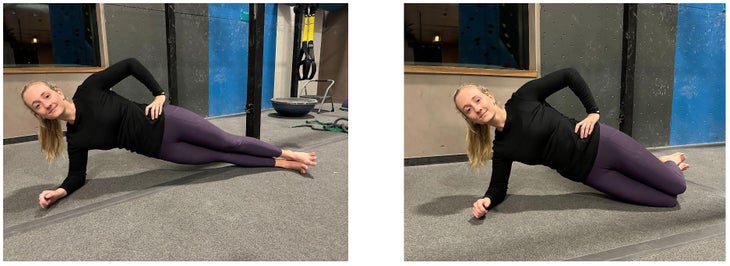
- In a side lying position, stack your elbow under your shoulders
- Keep a straight line from heel to hip to shoulders (shown above)
- If a full plank is too difficult, modify by putting your knees on the ground
- Find a time you can hold the position that feels challenging but doable. Repeat for 2-4 sets.
Planks (modified and full)
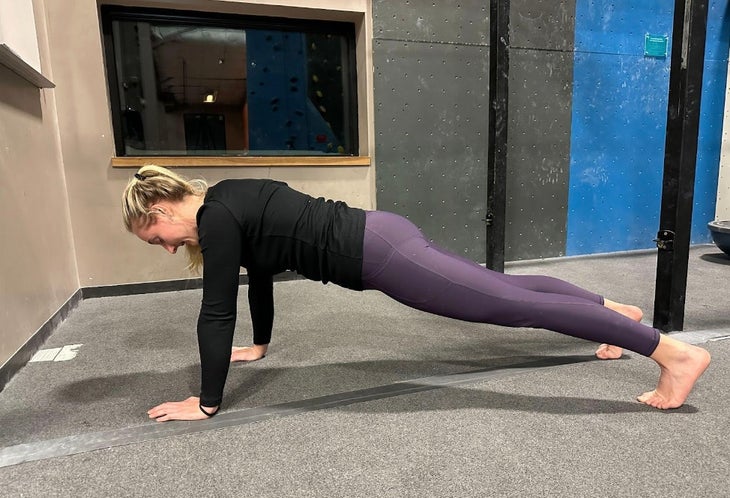
- Hold your body statically in the above position. Keep your body in a straight line from shoulders to hips to heels—don’t let your butt rise or your belly sag.
- Activate and push through your shoulders into the ground
- If a full plank is too difficult, modify by placing your knees on the ground
- Hold this position or a length of time that feels challenging but doable. Repeat for 2-4 sets.
Supine heel taps
- While laying on your back, draw in your abdominals towards your spine and lift your legs into a 90-90 position (90 degrees hip flexion, 90 degrees of knee flexion)
- Alternate tapping one heel to the ground at a time, returning back to the 90/90 position
- Pay special attention to your form—it is easy to cheat through this exercise! Is your back arching or coming off the ground? Are you over-crunching your abs to compensate?
- Only complete this exercise if you feel you can perform it without these compensations
- Repeat for 2-4 sets of 10 taps, modifying the amount based on fatigue
Spider-mans
- Start in a plank position
- Alternate drawing one knee out to the side and towards your elbow
- Focus on keeping the rest of your body still, isolating and moving only your leg
- Repeat 2-4 times for bouts of 30 seconds depending on fatigue
Hangboard abdominal activation

The hangboard is another great tool to start introducing abdominal activation in a hanging position. Instead of letting your body loosely hang while you warm up your fingers, incorporate an abdominal warmup as well. Here’s how:
- While hanging from a comfortable position (for example, start on the jugs), complete the same exhale and abdominal activation you completed on your back (described above)
- Focus on drawing your core in from the sides of your belly, not just “crunching” your six pack
- Move slowly and with control
- Complete 5 exhales and abdominal activations
If this feels easy, you can start to introduce knee tucks in this same position. Here’s how:
- While hanging exhale and draw your abdominals in
- Slowly bring your knees up to your chest and then release them back to a neutral hang
- Repeat 8-10 times, or stop when you feel your form is fatiguing
Your first few climbing sessions
Expect your first few climbing sessions to be very low intensity and on easy terrain (i.e. maxing out on the climbs you used to use for warmups). Make sure you do a thorough warmup including pelvic floor and abdominal activation. Focus on more vertical terrain and let your body tell you what it needs. Expect your sessions to be shorter and less frequent at first. Don’t worry, it won’t be like this forever.
Now is also a great time to focus on the skill of good climbing technique. Even on easy terrain, practice moving smoothly, deliberately placing your feet, and not re-adjusting multiple times on a single hold. This can be a valuable time to improve technique and pay it forward for when you’re back on difficult climbs.
Return to climbing timeline
This timeline can vary greatly depending on vaginal vs. C-section births, birth complications, and presence of pelvic floor and core dysfunction. Always listen to your body and see a professional if you are unsure of how to progress your climbing postpartum. Below is an example of what can be expected from a complication-free vaginal birth.
| Months Postpartum | Expectations |
| 6 weeks-4 months |
|
| 6 months |
|
| 9 months |
|
| 12 months |
|
| 18 months |
|
When to see a pelvic floor physical therapist
Most pelvic floor physical therapists believe that every woman should work with a PT throughout pregnancy and postpartum. In most European countries, this is even a standard of care. You should see a pelvic floor PT if you are:
- Experiencing pelvic pain during climbing or exercise
- Experiencing bowel or bladder incontinence during climbing or exercise
- Feeling a pressure or bulge in your vagina at rest or with activity
- Abdominal separation greater than two finger widths not resolving by 8 weeks postpartum
- Abdominal separation that you feel is affecting pain or function
- Unsure of how to safely exercise during and after pregnancy
Find a pelvic health physical therapist near you.
Additional resources
If you are interested in learning more about your pelvic floor through the lens of pregnancy and postpartum, here are some other resources that can be helpful:
- The Nugget Podcast Episode 128: Callie Joy Black—Training During Pregnancy, Climbing Hard with Kids, and Being Your Own Project
- Instagram: @climbingwithjoy
- Lattice Training: Pregnancy, Postpartum, Peri & Postmenopause in Climbing
- If you want to dive deeper into peer-reviewed literature: Maximizing Recovery in the Postpartum Period: A Timeline for Rehabilitation from Pregnancy through Return to Sport
- “Climbing for Two” The Climbing Doctor
About the author
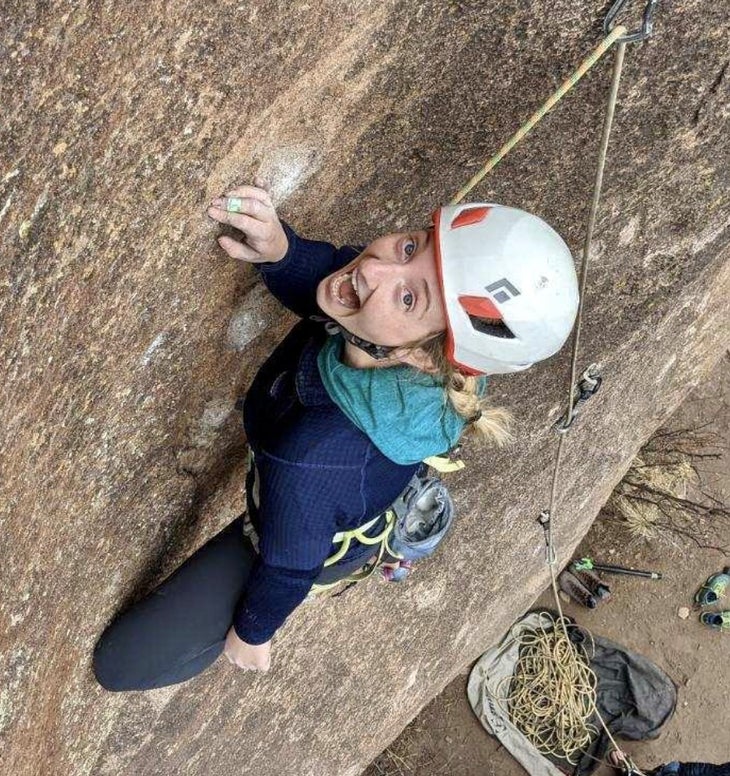
Grace Killeen is a Doctor of Physical Therapy student at the University of Colorado graduating at the end of 2024. She lives in Denver, where she enjoys climbing in the front range and beyond on anything crimpy and technical. Grace has a particular passion for women’s health and helping women feel strong and empowered through climbing. When she’s not climbing, she enjoys hiking, golfing, and reading. You can reach Grace at graceakilleen@gmail.com
About the contributors

Dr. Jared Vagy “The Climbing Doctor,” is a doctor of physical therapy and an experienced climber, has devoted his career and studies to climbing-related injury prevention, orthopedics, and movement science. He authored the Amazon best-selling book Climb Injury-Free, and is a frequent contributor to Climbing Magazine. He is also a professor at the University of Southern California, an internationally recognized lecturer, and a board-certified orthopedic clinical specialist.
To learn more about Dr. Vagy you can visit theclimbingdoctor.com or visit him on Instagram @theclimbingdoctor or YouTube youtube.com/c/TheClimbingDoctor

Kevin Cowell is a physical therapist, clinical instructor, and rock climber based out of Broomfield, CO. Kevin owns and operates The Climb Clinic (located at G1 Climbing + Fitness) where he specializes in rehab and strength training for climbers and mountain athletes. He found his passion for climbing in Colorado while attending Regis University for his Doctorate of Physical Therapy and has since become a Certified Strength & Conditioning Coach (CSCS), Board-Certified Orthopaedic Clinical Specialist (OCS), and a Fellow of the American Academy of Orthopaedic Manual Physical Therapy (FAAOMPT).
You can contact Kevin via email at kevin@theclimbclinic.com or by visiting www.theclimbclinic.com. Also, be sure to follow Kevin at @theclimbclinic on Instagram for free rehab and strength training resources.

Julien Descheneaux is a master of physical therapy who dedicates himself exclusively to rock climbing injuries, having treated over 1,200 climbers. He’s been covering Quebec competitions as a certified Sport First Responder since 2014. He is also the author of the online class “Climbing injuries at the upper quadrant” for the Quebec PT Board (OPPQ) and gives regular clinics and conferences on the subject. He founded PhysioHR in 2016, the first PT clinic inside a rock climbing gym in Canada and is currently the resident PT at Bloc Shop Chabanel.
You can contact Julien via email at julienlephysio@gmail.com or by visiting https://www.physioescalade.com/.
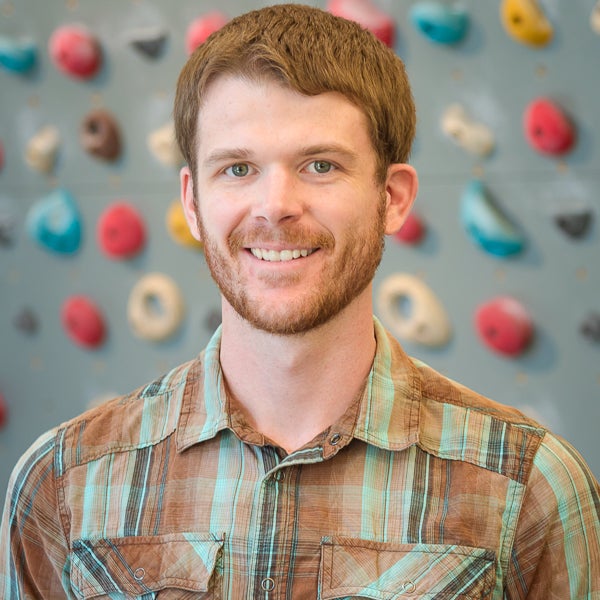
Todd Bushman is a doctor of physical therapy, clinical instructor, Certified Strength and Conditioning Specialist (CSCS), and climber of mountain, rock, ice, and plastic. Todd is a dedicated climbing specialist based out of Bozeman, MT where he practices full time. He is actively pursuing advanced training to become a Certified Orthopedic Manual Therapist (COMT) through the North American Institute of Orthopedic Manual Therapy. Todd is also available for remote consultation regarding climbing injuries, movement analysis, and strength training.
You can contact Todd via email at todd.climbingcoach@gmail.com or visit him @try.hard.pt on Instagram.

Carly Post is a physical therapist in Los Angeles, California. She is passionate about climbing and enjoys helping people move better and optimize their ability to participate in their lives to their fullest potential. She can be reached at carlypos@usc.edu and on Instagram at @carlypost
References
- Liaw LJ, Hsu MJ, Liao CF, Liu MF, Hsu AT. The relationships between inter-recti distance measured by ultrasound imaging and abdominal muscle function in postpartum women: a 6-month follow-up study. J Orthop Sports Phys Ther. 2011;41(6):435-443. doi:10.2519/jospt.2011.3507
- Pereira LC, Botelho S, Marques J, et al. Are transversus abdominis/oblique internal and pelvic floor muscles coactivated during pregnancy and postpartum?. Neurourol Urodyn. 2013;32(5):416-419. doi:10.1002/nau.22315
- Sperstad JB, Tennfjord MK, Hilde G, Ellström-Engh M, Bø K. Diastasis recti abdominis during pregnancy and 12 months after childbirth: prevalence, risk factors and report of lumbopelvic pain. Br J Sports Med. 2016;50(17):1092-1096. doi:10.1136/bjsports-2016-096065
- Selman R, Early K, Battles B, Seidenburg M, Wendel E, Westerlund S. Maximizing Recovery in the Postpartum Period: A Timeline for Rehabilitation from Pregnancy through Return to Sport. Int J Sports Phys Ther. 2022 Oct 1;17(6):1170-1183. doi: 10.26603/001c.37863. PMID: 36237644; PMCID: PMC9528725.
- Evenson KR, Mottola MF, Owe KM, Rousham EK, Brown WJ. Summary of international guidelines for physical activity after pregnancy. Obstet Gynecol Surv. 2014 Jul;69(7):407-14. doi: 10.1097/OGX.0000000000000077. PMID: 25112589; PMCID: PMC4134098.
- Clinical expertise from Dr. Juliana Merighi, PT, DPT, CSCS, RYT-200
- Instagram: @climbingwithjoy
The post What’s the Post-Baby Beta? How to Return to Climbing After Pregnancy appeared first on Climbing.
]]>